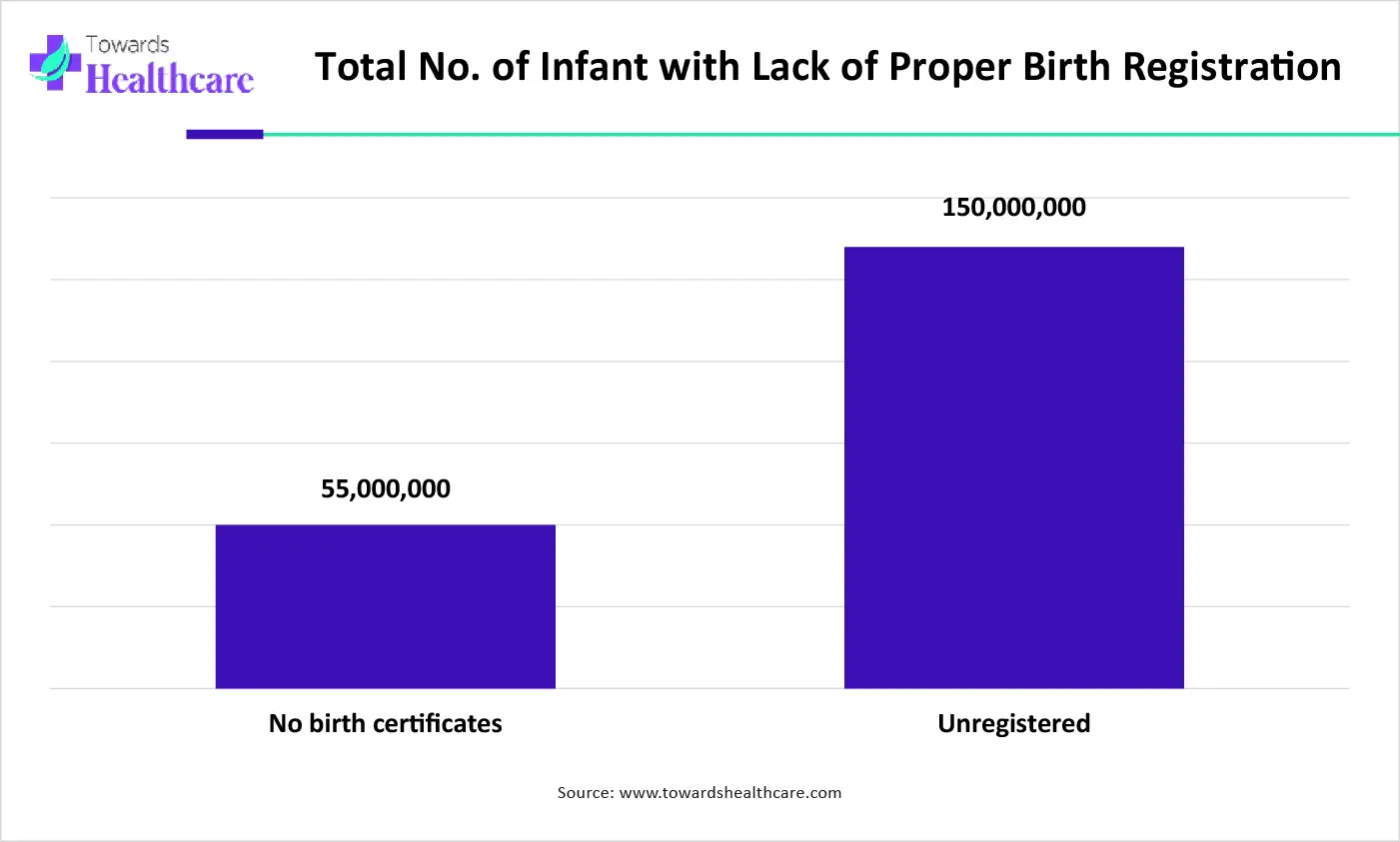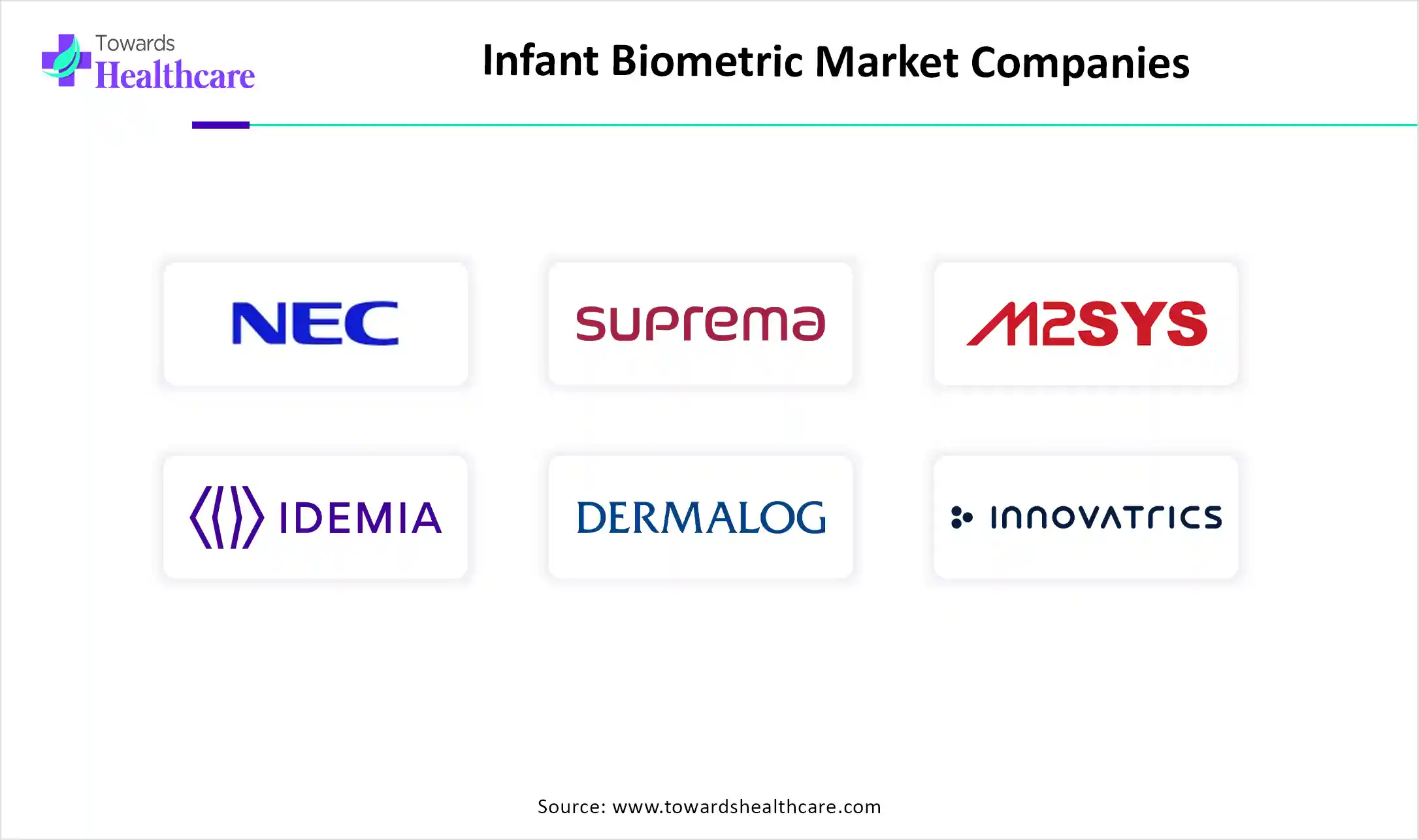November 2025

The global infant biometrics market is on an upward trajectory, poised to generate substantial revenue growth, potentially climbing into the hundreds of millions over the forecast years from 2025 to 2034. This surge is attributed to evolving consumer preferences and technological advancements reshaping the industry.
The use of infant biometrics is increasing for recording birth registration, immunization tracking, healthcare delivery, etc. At the same time, their use is also supported by the government. Moreover, the use of AI is improving its various features, enhancing its use. This, in turn, is also resulting in new collaborations among the companies. Additionally, their use is also increasing in different regions, due to advanced or robust healthcare sectors, as well as growing birth rates. Thus, all these factors are promoting the market growth.
The infant biometric market refers to technologies, solutions, and systems used to uniquely identify and authenticate infants (typically under 1 year of age) using biometric modalities such as fingerprint, palmprint, footprint, iris, and facial recognition. These solutions support healthcare delivery, immunization tracking, birth registration, anti-abduction security, and medical record continuity in hospitals, civil registries, and humanitarian programs. Moreover, it is also transforming the identity management of infants with biometric verification. This, in turn, is helping to develop an infrastructure that is accessible, secure, and accurate for future digital identity verification.
The integration of AI in infant biometrics is transforming identity verification. With the use of AI, biometric authentication is being improved. Moreover, by analyzing various behavioural and physical characteristics such as facial features, voice patterns, and fingerprints, the AI is enhancing the infant's biometric precision and efficiency. The biometric accuracy is also enhanced with the use of AI algorithms, which can easily process a large volume of data, using fingerprint scanning, facial recognition, and other authentication methods. Furthermore, it also improves the convenience and security of infant biometrics.
Rising Birth Rates
The growing birth rates are increasing the demand for infant biometric systems. With the use of these systems, the hospitals can easily record their identity or health records. Moreover, it can also be useful for tracking their vaccination schedules and medical records. This, in turn, also helps to prevent infant swapping, or identity mixups. At the same time, as it can track the infant, it becomes easier to provide them with essential services by the government. Hence, this promotes the infant biometric market growth.

The graph represents the total number of infants with improper registration globally. It indicates that there is a rise in registration issues of the infants. Hence, it increases the demand for infant biometric systems for their effective management. Thus, this in turn will ultimately promote the market growth.
Limited Biometric Features
The infant biometric can record the facial, finger, or ear features to track them, but as they grow rapidly, these data may lack accuracy, decreasing their reliability. Moreover, inaccurate data can be recorded as the infant tends to move continuously. It also increases concerns for data security and privacy.
Why is the Growing Demand for Infant Identification Systems an Opportunity in the Infant Biometric Market?
The increasing birth rates are increasing various issues such as misidentification, child trafficking, immunization gaps, etc. Thus, the demand for the use of infant biometrics is increasing. The hospitals are utilizing it to reduce these risks, provide anti-abduction security, and monitor the growth as well as the healthcare delivery solution to the infant. At the same time, the government is also supporting it to provide various other infant benefits along with early identity proof. Thus, the growing demand for infant identification systems promotes the infant biometric market growth.
For instance,
By technology type, the fingerprint recognition segment held the largest share of the market with 100% in 2024. Due to high rates of accuracy, the use of fingerprint recognition for registering the infants increased. At the same time, the affordability of the technology contributed to its increased use. Thus, this enhanced the market growth.
By technology type, the iris recognition segment is expected to show the fastest growth rate at a notable CAGR during the predicted time. The iris recognition provides an accurate and stable pattern for the identification of infants. Moreover, the risk of infection in infants is also reduced as they don't require any contact with the infected infants.
By component type, the biometric scanners segment led the market with 70% in 2024. The biometric scanners were important for recording the data of infants. Furthermore, they were also used by hospitals for proper registration of infants by scanning the fingerprints, iris, palmprint, footprint, or face. This contributed to the market growth.
By component type, the infant-specific biometric algorithms segment is expected to show the highest growth during the predicted time. With the help of infant-specific biometric algorithms, the changing fingerprints, palmprint, footprint, and facial features can be easily recorded and tracked. This, in turn, increases its accuracy and reliability.
By application type, the newborn identification in hospitals segment led the market with 50% in 2024. The growing birth rates are increasing the risk of child swapping and misidentification. This, in turn, increased the newborn identification in hospitals. This helped in the proper registration and healthcare delivery for infants.
By application type, the others segment is expected to show the fastest growth rate during the upcoming years. The use of infant biometrics provides various other applications such as protecting the child from swapping or diseases. This, in turn, is increasing their use by various government programs to provide different benefits from the government.
By end user, the hospitals and neonatal care units segment held the dominating share of the global market with 100% in 2024. The hospitals and neonatal care units provided the biometric registration after the birth of babies. Moreover, it was also used in immunization tracking, anti-abduction security, or for medical record continuity of the infants, promoting the market growth.
By end user, the others segment is expected to show the highest growth during the upcoming years. The use of infant biometrics is increasing to protect the children in war zones, child trafficking, refugee camps, etc. Furthermore, to monitor their adoption or provide government benefits, their use is increasing.
North America dominated the infant biometric market in 2024. North America consisted of a well-developed healthcare sector along with advanced technologies. This, in turn, increased the production and development of infant biometrics. Thus, this contributed to the market growth.
The industries in the U.S. are developing various new biometric platforms for enhancing the enrollment of infants and reducing errors. At the same time, various programs are also being conducted to promote their use and avoid improper birth registration, child swapping, etc.
The advanced healthcare in Canada is increasing the use of infant biometrics for various purposes. Moreover, different initiatives are also being introduced by the government to protect babies from trafficking. In addition to monitoring the health of the infants and protecting them from diseases, its use is growing.
Asia Pacific is expected to host the fastest-growing infant biometric market during the forecast period. Asia Pacific is experiencing a rise in birth rates, which in turn is increasing the demand for the use of infant biometric systems. Moreover, the industries are also supporting their development. This enhances the market growth.
Due to the growing population, China is adopting various advanced technologies to increase the development of infant biometric systems for their proper registration and identification. At the same time, to boost the vaccination of the infants, their use is growing, which is supported by the government.
The growing birth rates and expanding healthcare in India are driving the demand for the use of infant biometric platforms. Additionally, the companies are collaborating to develop and enhance their features. This, in turn, is supported by the government investments, to make them more accessible and affordable.
Europe is expected to grow significantly in the infant biometric market during the forecast period. The healthcare sector in Europe is well developed, which utilizes advanced technologies for maintaining health records. This, in turn, encourages the use of infant biometrics, promoting the market growth.
The use of infant biometrics in Germany is increasing in the healthcare sector to minimize misconduct and enhance proper birth registration. At the same time, various rules and regulations are also being imposed by the government to ensure the safe and efficient use of these infant biometrics.
The industries in the UK are developing new infant biometric platforms to enhance their use. Moreover, with the use of advanced technologies, small portable biometric devices are being developed, which in turn is leading to new collaborations. Furthermore, to promote their adoption and use, the government is also providing its support.

By Technology
By Component (Fingerprint Recognition)
By Application
By End User
By Region
November 2025
November 2025
October 2025
October 2025